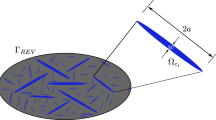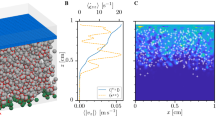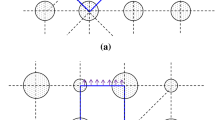Abstract
This paper investigates the permeability of microcracked porous solids containing 2D random crack networks. The past works on permeability of crack networks are firstly reviewed. The geometry analysis is performed on numerical samples of crack networks with different crack length distributions, crack densities, domain size ratios and clustering degrees. The parameters from continuum percolation theory are used to characterize the geometry of random networks including the percolation threshold, the scaling exponents for percolation probability and correlation length of crack clusters, and the fractal dimension of spanning clusters. The crack density is used as the basic percolation variable, and a new connectivity factor is proposed for the cluster spanning in finite domain. Then the effective permeability of porous matrix containing 2D random crack networks is analyzed on numerical samples via finite element method. A scaling law for effective permeability is established near the percolation threshold taking into account the matrix permeability, crack opening aperture, crack connectivity and tortuosity. The results from geometry analysis and permeability analysis show that: (1) The new connectivity factor is proved pertinent to network percolation, related to both crack density and crack clustering degree; (2) the percolation parameters of uncorrelated crack networks are rather near to the universal values from the continuum percolation theory, but their values change with the clustering degree of crack networks; (3) the numerical results confirm the scaling law proposed for effective permeability, and the permeability is found to scale with the crack opening through a power law.














Similar content being viewed by others
References
Adler, P.M., Thovert, J.F.: Fracture and Fracture Networks. Kluwer, Dordrecht (1999)
Adler, P.M., Thovert, J.F., Mourzenko, V.V.: Fractured Porous Media. Oxford, London (2013)
Berkowitz, B.: Analysis of fracture network connectivity using percolation theory. Math. Geol. 27(4), 467–483 (1995)
Berkowitz, B., Ewing, R.P.: Percolation theory and network modeling applications in soil physics. Surv. Geophys. 19(1), 23–72 (1998)
Berryman, J.G., Hoversten, G.M.: Modelling electrical conductivity for earth media with macroscopic fluid-filled fractures. Geophys. Prospect. 61(2), 471–493 (2012)
Bogdanov, I.I., Mourzenko, V.V., Thovert, J.F., Adler, P.M.: Effective permeability of fractured porous media in steady state flow. Water Resour. Res. 39(1), 1023 (2003)
Bonnet, E., Bour, O., Odling, N.E., Davy, P., Main, I., Cowie, P., Berkowitz, B.: Scaling of fracture systems in geological media. Rev. Geophys. 39(3), 347–383 (2001)
Bour, O., Davy, P.: Connectivity of random fault networks following a power law fault length distribution. Water Resour. Res. 33(7), 1567–1583 (1997)
Darcel, C., Bour, O., Davy, P., de Dreuzy, J.R.: Connectivity properties of two-dimensional fracture networks with stochastic fractal correlation. Water Resour. Res. 39(10), 1272 (2003)
Davy, P., Sornette, A., Sornette, D.: Some consequences of a proposed fractal nature of continental faulting. Nature 348(6296), 56–58 (1990)
de Dreuzy, J.R., Davy, P., Bour, O.: Hydraulic properties of two-dimensional random fracture networks following a power law length distribution: 1. Effective connectivity. Water Resour. Res. 37(8), 2065–2078 (2001a)
de Dreuzy, J.R., Davy, P., Bour, O.: Hydraulic properties of two-dimensional random fracture networks following a power law length distribution: 2. Permeability of networks based on lognormal distribution of apertures. Water Resour. Res. 37(8), 2079–2095 (2001b)
de Dreuzy, J.R., Davy, P., Bour, O.: Hydraulic properties of two-dimensional random fracture networks following power law distributions of length and aperture. Water Resour. Res. 38(12), 1276 (2002)
Desbarats, A.J.: Spatial averaging of hydraulic conductivity in three-dimensional heterogeneous porous media. Math. Geol. 24(3), 249–267 (1992)
Guéguen, Y., Dienes, J.: Transport properties of rocks from statistics and percolation. Math. Geol. 21(1), 1–13 (1989)
Guéguen, Y., Chelidze, T., Le Ravalec, M.: Microstructures, percolation thresholds, and rock physical properties. Tectonophysics 279(1), 23–35 (1997)
Halperin, B.I., Feng, S., Sen, P.N.: Differences between lattice and continuum percolation transport exponents. Phys. Rev. Lett. 54(22), 2391 (1985)
Hearn, N.: Effect of shrinkage and load-induced cracking on water permeability of concrete. ACI Mater. J. 96, 234–241 (1999)
Hestir, K., Long, J.: Analytical expressions for the permeability of random two-dimensional Poisson fracture networks based on regular lattice percolation and equivalent media theories. J. Geophys. Res. 95(B13), 21565–21581 (1990)
Hunt, A., Ewing, R.: Percolation Theory for Flow in Porous Media. Springer, Berlin (2009)
Jafari, A., Babadagli, T.: Relationship between percolation-fractal properties and permeability of 2-D fracture networks. Int. J. Rock Mech. Min. Sci. 60, 353–362 (2013)
Kachanov, M.: Effective elastic properties of cracked solids: critical review of some basic concepts. Appl. Mech. Rev. 45(8), 304–335 (1992)
Lee, Y., Andrade Jr, J.S., Buldyrev, S.V., Dokholyan, N.V., Havlin, S., King, P.R., Paul, G., Stanley, H.E.: Traveling time and traveling length in critical percolation clusters. Phys. Rev. E 60(3), 3425–3428 (1999)
Lespinasse, M., Désindes, L., Fratczak, P., Petrov, V.: Microfissural mapping of natural cracks in rocks: implications for fluid transfers quantification in the crust. Chem. Geol. 223(1–3), 170–178 (2005)
Leung, C.T.O., Zimmerman, R.W.: Estimating the hydraulic conductivity of two-dimensional fracture networks using network geometric properties. Transp. Porous Media. 93(3), 777–797 (2012)
Li, J.H., Zhang, L.M.: Connectivity of a network of random discontinuities. Comput. Geotech. 38(2), 217–226 (2011)
Loosveldt, H., Lafhaj, Z., Skoczylas, F.: Experimental study of gas and liquid permeability of a mortar. Cem. Concr. Res. 32(9), 1357–1363 (2002)
Mandelbrot, B.B.: The fractal geometry of nature. W. H. Freeman, New York (1983)
Masihi, M., King, P.R.: A correlated fracture network: modeling and percolation properties. Water Resour. Res. 43(7), W07439 (2007)
Mourzenko, V.V., Thovert, J.F., Adler, P.M.: Macroscopic permeability of three-dimensional fracture networks with power-law size distribution. Phys. Rev. E. 69(6), 066307 (2004)
Norris, A.N.: A differential scheme for the effective moduli of composites. Mech. Mater. 4(1), 1–16 (1985)
Pan, J.B., Lee, C.C., Lee, C.H., Yeh, H.F., Lin, H.I.: Application of fracture network model with crack permeability tensor on flow and transport in fractured rock. Eng. Geol. 116(1–2), 166–177 (2010)
Pouya, A., Ghabezloo, S.: Flow around a crack in a porous matrix and related problems. Transp. Porous Media. 84(2), 511–532 (2010)
Robinson, P.C.: Numerical calculations of critical densities for lines and planes. J. Phys. A 17(14), 2823–2830 (1984)
Sadeghnejad, S., Masihi, M., King, P.R.: Dependency of percolation critical exponents on the exponent of power law size distribution. Phys. A 392(24), 6189–6197 (2013)
Samaha, H.R., Hover, K.C.: Influence of microcracking on the mass transport properties. ACI Mater. J. 89, 416–424 (1992)
Shafiro, B., Kachanov, M.: Anisotropic effective conductivity of materials with nonrandomly oriented inclusions of diverse ellipsoidal shapes. J. Appl. Phys. 87(12), 8561–8569 (2000)
Sheppard, A.P., Knackstedt, M.A., Pinczewski, W.V., Sahimi, M.: Invasion percolation: new algorithms and universality classes. J. Phys. A 32(49), L521–L529 (1999)
Somette, D.: Critical transport and failure in continuum crack percolation. J. Phys. 49(8), 1365–1377 (1988)
Stauffer, D.: Scaling theory of percolation clusters. Phys. Rep. 54(1), 1–74 (1979)
Stauffer, D., Aharony, A.: Introduction to Percolation Theory. Taylor & Francis, London (2003)
Suzuki, K., Oda, M., Yamazaki, M., Kuwahara, T.: Permeability changes in granite with crack growth during immersion in hot water. Int. J. Rock Mech. Min. Sci. 35(7), 907–921 (1998)
Torquato, S.: Random heterogeneous media: microstructure and improved bounds on effective properties. Appl. Mech. Rev. 44(2), 37–76 (1991)
Wilke, S., Guyon, E., de Marsily, G.: Water penetration through fractured rocks: test of a tridimensional percolation description. J. Int. Assoc. Math. Geol. 17(1), 17–27 (1985)
Wong, P., Koplik, J., Tomanic, J.P.: Conductivity and permeability of rocks. Phys. Rev. B 30(11), 6606–6614 (1984)
Yazdi, A., Hamzehpour, H., Sahimi, M.: Permeability, porosity, and percolation properties of two-dimensional disordered fracture networks. Phys. Rev. E 84(4), 046317 (2011)
Zheng, Q.S., Du, D.X.: An explicit and universally applicable estimate for the effective properties of multiphase composites which accounts for inclusion distribution. J. Mech. Phys. Solids 49(11), 2765–2788 (2001)
Zhou, C., Li, K., Pang, X.: Effect of crack density and connectivity on the permeability of microcracked solids. Mech. Mater. 43(12), 969–978 (2011)
Zhou, C., Li, K., Pang, X.: Geometry of crack network and its impact on transport properties of concrete. Cem. Concr. Res. 42(9), 1261–1272 (2012)
Author information
Authors and Affiliations
Corresponding author
Rights and permissions
About this article
Cite this article
Li, L., Li, K. Permeability of Microcracked Solids with Random Crack Networks: Role of Connectivity and Opening Aperture. Transp Porous Med 109, 217–237 (2015). https://doi.org/10.1007/s11242-015-0510-0
Received:
Accepted:
Published:
Issue Date:
DOI: https://doi.org/10.1007/s11242-015-0510-0




